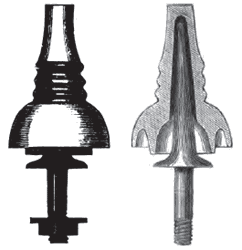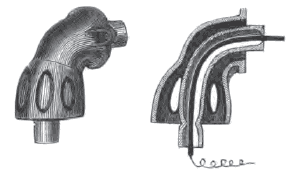[Trade Journal]
Publication: The Telegraphic Journal and Electrical Review
London, England
vol. 11, p. 475, col. 1-2
LANGDONS IMPROVED LEAD-IN
INSULATOR
UP to the present time the only form of terminal insulator in very general use has been the Bright's shackle. This arrangement, although mechanically all that can be desired, is electrically very defective, the insulation of a complete shackle termination at its best being but 1/8th that of an ordinary insulator. The general method of leading the wire into the office from a terminal is also by no means a satisfactory arrangement. Mr. W. Langdon, the well-known telegraph engineer of the Midland Railway, has recently devised a very effective form of terminal insulator, and also an improved leading-in cup, which are decided advances on anything yet brought out. Figs. 1 and 2 show the new form of insulator. It will be seen that great mechanical strength is obtained by carrying the metal bolt a considerable distance up into the porcelain cup, so that the pull of the wire, which would in an ordinary insulator have to be borne by the porcelain alone, is here practically brought to bear on the bolt. By giving a very broad base to the flange of the bolt, the tendency of the whole insulator to become pulled over by the strain of the wire becomes reduced to a minimum. The bolt, it may be remarked, is constructed to withstand a strain of from 1,100 to 1,200 Ibs. The insulator is provided with grooves, either of which may be used for the line-wire; but which will also be found particularly useful where copper wire is employed in conjunction with iron, the iron wire in such cases being attached at the lower, and the copper wire at the upper groove, the connection being formed by the ordinary loop. The bolt is of the usual dimensions, viz: to serve the ordinary 2-1/2 in. by 3 in. terminal arm; it can be fitted to the ordinary shackle straps if desired, by slipping a short piece of iron tube over the bolt and between the upper and lower straps, so as to keep the two straps apart.
 |
| Figs. 1 and 2. |
The "leading-in cup," shown by figs. 3 and 4, is formed by enclosing an insulating tube composed of glass or porcelain in a perforated iron hood. The insulator tube projects at each end, at that nearest the pole for the purpose of embedding it in the pole, and at the distant end that it may, by means of the perforation in the iron hood, become well cleansed by the rain. At a short distance from the mouth of the insulating tube, the space through which the gutta-percha arm is passed is contracted so as to centralise it, and thus keep it from touching the edge of the tube. A felt washer is used between the insulator and the pole. These leading-in cups have been employed for terminations, on "boxing" fixed to ordinary round creosoted poles, as well as on spare poles; in either case they form a very efficient and neat termination.
 |
| Figs. 3 and 4. |
